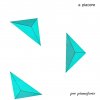A piacere
A piacere. Propositions for piano (1962–63)
{slider=A piacere. Propositions for piano /fragment/}
Frederic Rzewski – piano, „Warsaw Autumn” 1963
{/slider}
The work is Serocki’s first approach to the problem of open form in music. At the same time it constitutes his own attempt to put this idea into practice on the basis of sound material organised into short, easily identifiable sections – “structures”. However, the similarity of this solution to Karlheinz Stockhausen’s Klavierstück XI is merely superficial and is reflected in the way these smallest constitutive fragments of the work are notated (in rectangular boxes). In addition, they are grouped into bigger units – “segments” – also notated in boxes. Yet in this case freedom to choose the order of playing the “structures” and “segments” does not signify chance; the performer needs to think over the structural and dramatic concept of the whole work and then to proceed as he or she likes (“a piacere”).
Here is the composer’s own detailed commentary included in the programme booklet of the 7th “Warsaw Autumn” in 1963:
The piece, written in late 1962 and early 1963, consists of three segments, with each segment consisting of ten structures. The notation allows the performer some interpretative freedom within the specified time proportions. However, the piece may not last shorter than 6 and longer than 8 minutes. The order in which the various structures are performed within each segment as well as the order of performing the segments are at the pianist’s discretion. Thus, it is an aleatory work with an “open comprehensive form”. Open – because the performer can shape its progression as he or she wishes. Comprehensive – because it is based on a complete utilisation of a specific, basic sound material (none of the structures can be omitted or repeated). Despite such a “free” structure, each segment has a different musical “character”, which emphasises the “three-part nature” of the work.







